Report on Leadership and HR Practices in an IT Consultancy Company
VerifiedAdded on 2019/12/03
|15
|5611
|64
Report
AI Summary
This report provides a detailed analysis of leadership and human resource practices within an IT consultancy company. It begins by examining the recruitment, selection, and retention processes, including the preparation of job descriptions and specifications, the use of social media for advertising, and the impact of legal, regulatory, and ethical considerations. The report then delves into the role of the HR manager in the selection process, emphasizing the importance of adhering to equal opportunity and non-discriminatory policies. Furthermore, the report explores the skills and attributes essential for effective leadership, differentiating between leadership and management styles. It also discusses motivational theories and the significance of teamwork in achieving strategic business goals. The report utilizes a case study approach to illustrate these concepts, offering practical insights into how the IT consultancy can improve its leadership and HR practices to enhance organizational success.
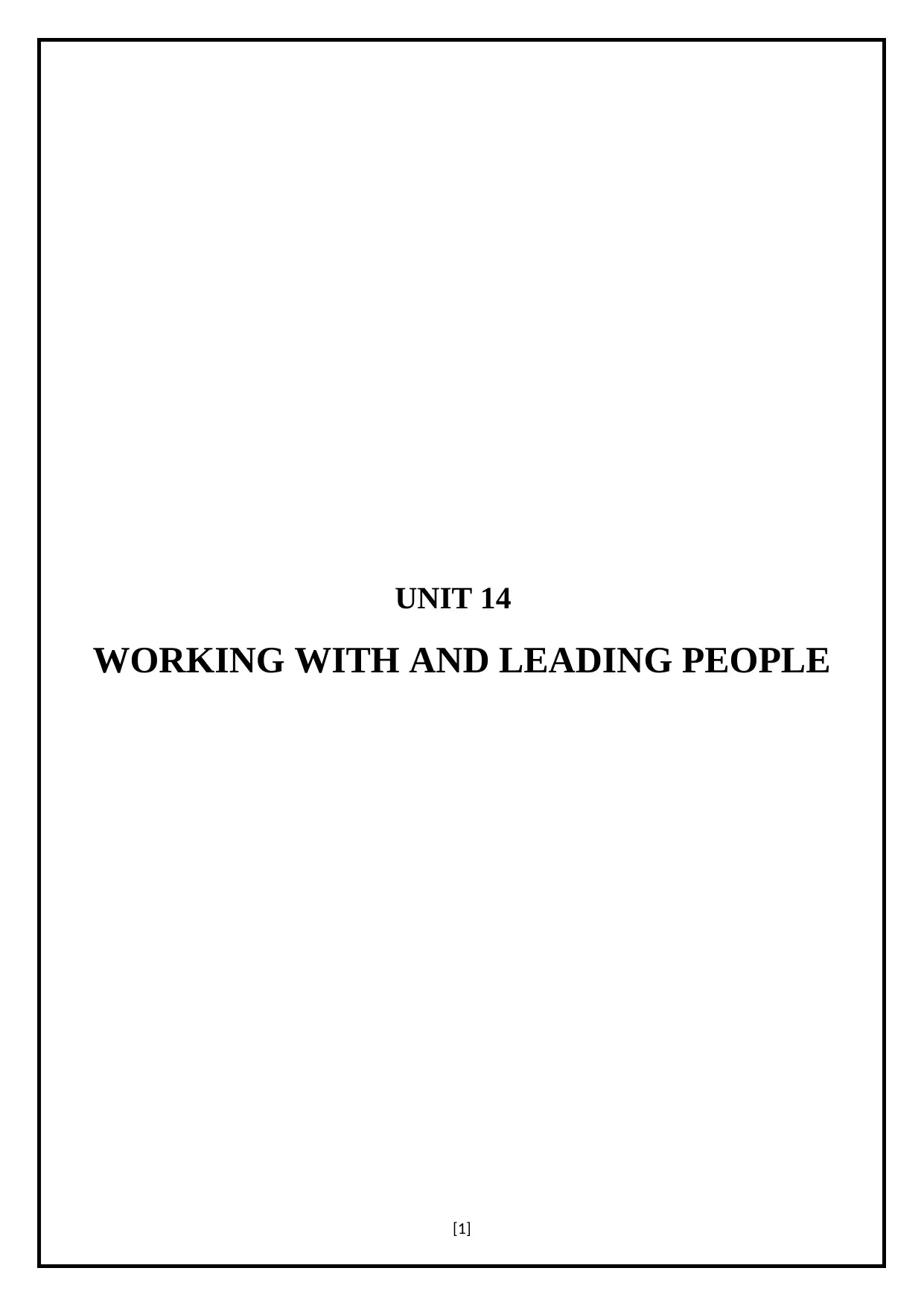
UNIT 14
WORKING WITH AND LEADING PEOPLE
[1]
WORKING WITH AND LEADING PEOPLE
[1]
Paraphrase This Document
Need a fresh take? Get an instant paraphrase of this document with our AI Paraphraser
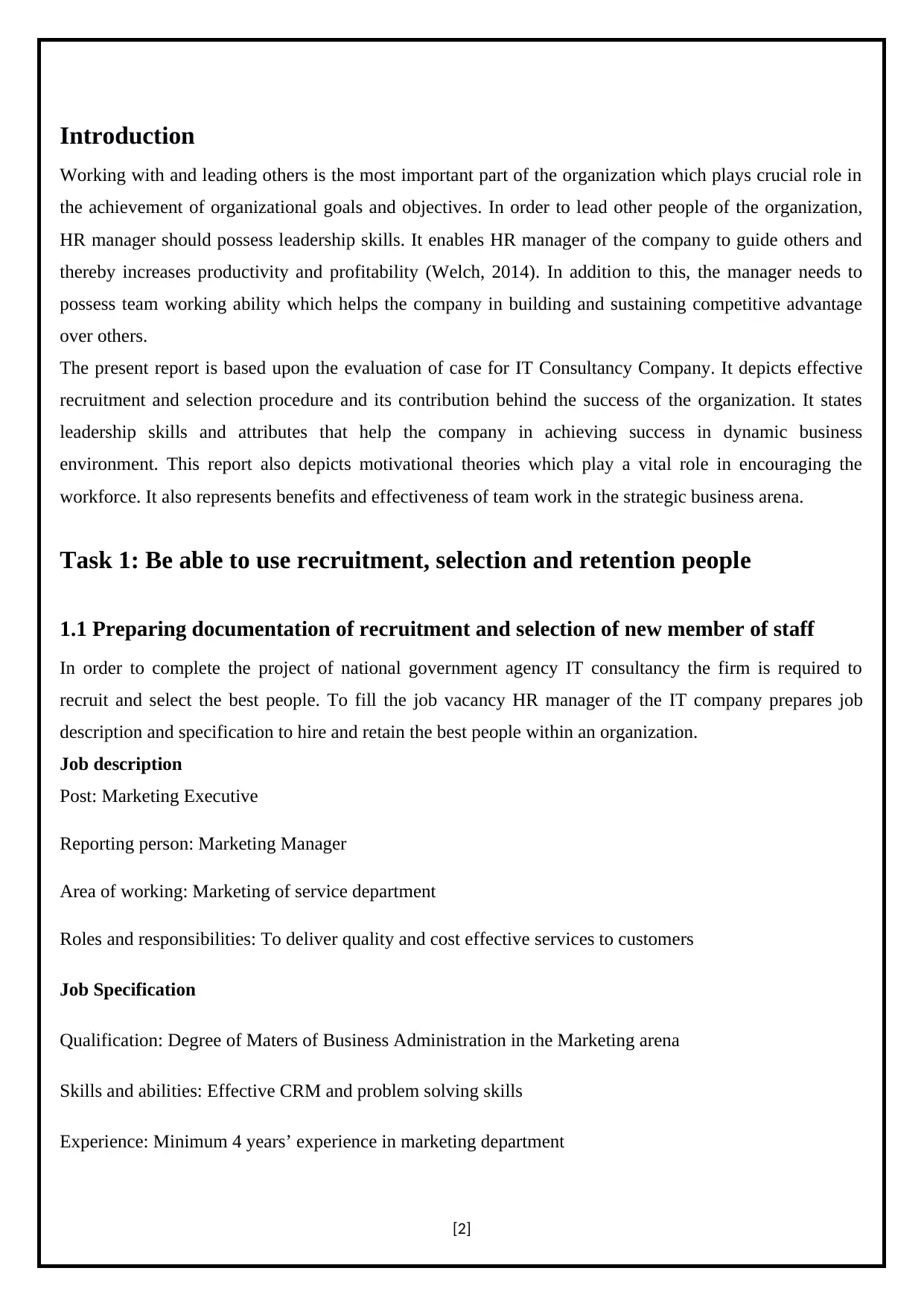
Introduction
Working with and leading others is the most important part of the organization which plays crucial role in
the achievement of organizational goals and objectives. In order to lead other people of the organization,
HR manager should possess leadership skills. It enables HR manager of the company to guide others and
thereby increases productivity and profitability (Welch, 2014). In addition to this, the manager needs to
possess team working ability which helps the company in building and sustaining competitive advantage
over others.
The present report is based upon the evaluation of case for IT Consultancy Company. It depicts effective
recruitment and selection procedure and its contribution behind the success of the organization. It states
leadership skills and attributes that help the company in achieving success in dynamic business
environment. This report also depicts motivational theories which play a vital role in encouraging the
workforce. It also represents benefits and effectiveness of team work in the strategic business arena.
Task 1: Be able to use recruitment, selection and retention people
1.1 Preparing documentation of recruitment and selection of new member of staff
In order to complete the project of national government agency IT consultancy the firm is required to
recruit and select the best people. To fill the job vacancy HR manager of the IT company prepares job
description and specification to hire and retain the best people within an organization.
Job description
Post: Marketing Executive
Reporting person: Marketing Manager
Area of working: Marketing of service department
Roles and responsibilities: To deliver quality and cost effective services to customers
Job Specification
Qualification: Degree of Maters of Business Administration in the Marketing arena
Skills and abilities: Effective CRM and problem solving skills
Experience: Minimum 4 years’ experience in marketing department
[2]
Working with and leading others is the most important part of the organization which plays crucial role in
the achievement of organizational goals and objectives. In order to lead other people of the organization,
HR manager should possess leadership skills. It enables HR manager of the company to guide others and
thereby increases productivity and profitability (Welch, 2014). In addition to this, the manager needs to
possess team working ability which helps the company in building and sustaining competitive advantage
over others.
The present report is based upon the evaluation of case for IT Consultancy Company. It depicts effective
recruitment and selection procedure and its contribution behind the success of the organization. It states
leadership skills and attributes that help the company in achieving success in dynamic business
environment. This report also depicts motivational theories which play a vital role in encouraging the
workforce. It also represents benefits and effectiveness of team work in the strategic business arena.
Task 1: Be able to use recruitment, selection and retention people
1.1 Preparing documentation of recruitment and selection of new member of staff
In order to complete the project of national government agency IT consultancy the firm is required to
recruit and select the best people. To fill the job vacancy HR manager of the IT company prepares job
description and specification to hire and retain the best people within an organization.
Job description
Post: Marketing Executive
Reporting person: Marketing Manager
Area of working: Marketing of service department
Roles and responsibilities: To deliver quality and cost effective services to customers
Job Specification
Qualification: Degree of Maters of Business Administration in the Marketing arena
Skills and abilities: Effective CRM and problem solving skills
Experience: Minimum 4 years’ experience in marketing department
[2]
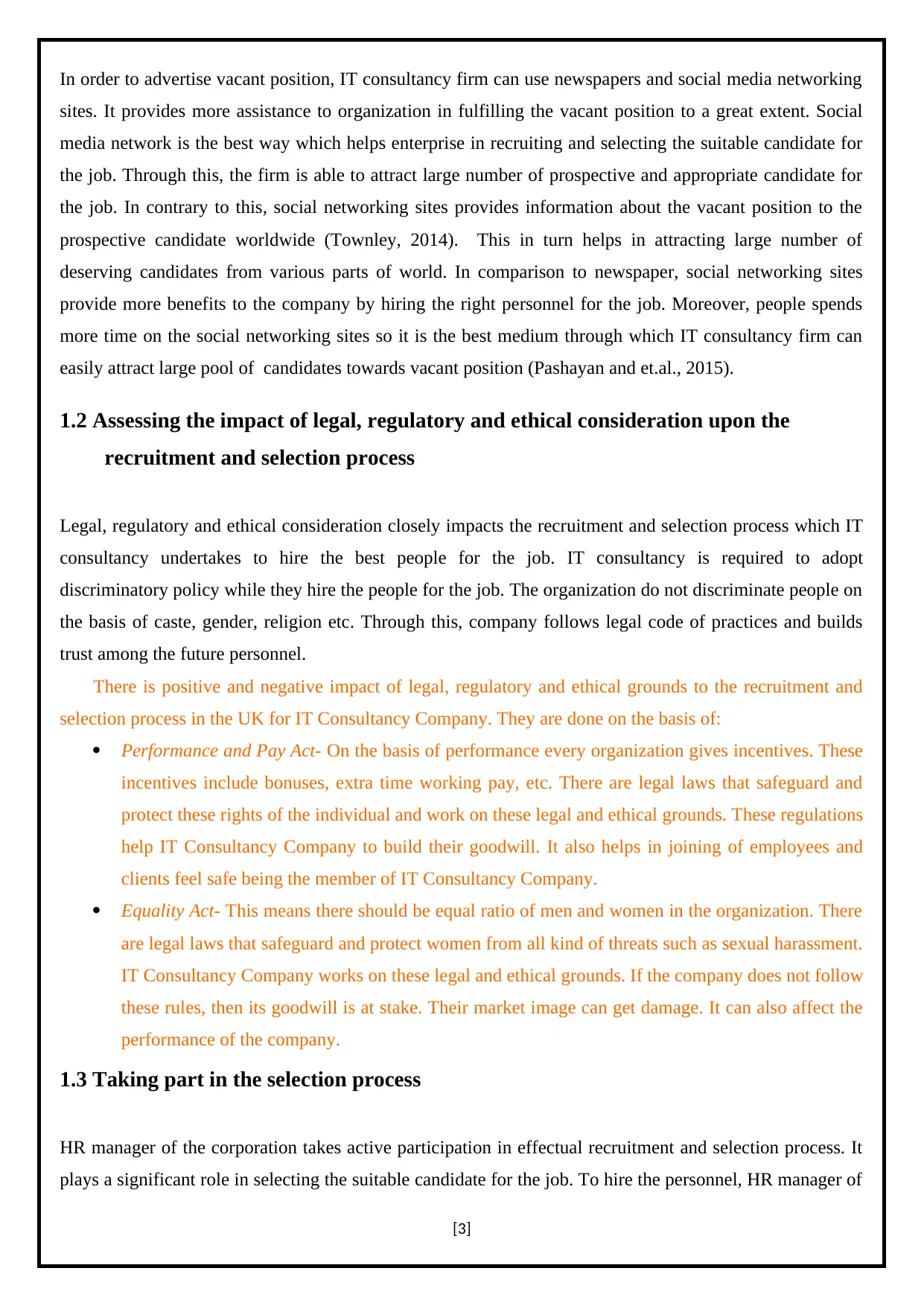
In order to advertise vacant position, IT consultancy firm can use newspapers and social media networking
sites. It provides more assistance to organization in fulfilling the vacant position to a great extent. Social
media network is the best way which helps enterprise in recruiting and selecting the suitable candidate for
the job. Through this, the firm is able to attract large number of prospective and appropriate candidate for
the job. In contrary to this, social networking sites provides information about the vacant position to the
prospective candidate worldwide (Townley, 2014). This in turn helps in attracting large number of
deserving candidates from various parts of world. In comparison to newspaper, social networking sites
provide more benefits to the company by hiring the right personnel for the job. Moreover, people spends
more time on the social networking sites so it is the best medium through which IT consultancy firm can
easily attract large pool of candidates towards vacant position (Pashayan and et.al., 2015).
1.2 Assessing the impact of legal, regulatory and ethical consideration upon the
recruitment and selection process
Legal, regulatory and ethical consideration closely impacts the recruitment and selection process which IT
consultancy undertakes to hire the best people for the job. IT consultancy is required to adopt
discriminatory policy while they hire the people for the job. The organization do not discriminate people on
the basis of caste, gender, religion etc. Through this, company follows legal code of practices and builds
trust among the future personnel.
There is positive and negative impact of legal, regulatory and ethical grounds to the recruitment and
selection process in the UK for IT Consultancy Company. They are done on the basis of:
Performance and Pay Act- On the basis of performance every organization gives incentives. These
incentives include bonuses, extra time working pay, etc. There are legal laws that safeguard and
protect these rights of the individual and work on these legal and ethical grounds. These regulations
help IT Consultancy Company to build their goodwill. It also helps in joining of employees and
clients feel safe being the member of IT Consultancy Company.
Equality Act- This means there should be equal ratio of men and women in the organization. There
are legal laws that safeguard and protect women from all kind of threats such as sexual harassment.
IT Consultancy Company works on these legal and ethical grounds. If the company does not follow
these rules, then its goodwill is at stake. Their market image can get damage. It can also affect the
performance of the company.
1.3 Taking part in the selection process
HR manager of the corporation takes active participation in effectual recruitment and selection process. It
plays a significant role in selecting the suitable candidate for the job. To hire the personnel, HR manager of
[3]
sites. It provides more assistance to organization in fulfilling the vacant position to a great extent. Social
media network is the best way which helps enterprise in recruiting and selecting the suitable candidate for
the job. Through this, the firm is able to attract large number of prospective and appropriate candidate for
the job. In contrary to this, social networking sites provides information about the vacant position to the
prospective candidate worldwide (Townley, 2014). This in turn helps in attracting large number of
deserving candidates from various parts of world. In comparison to newspaper, social networking sites
provide more benefits to the company by hiring the right personnel for the job. Moreover, people spends
more time on the social networking sites so it is the best medium through which IT consultancy firm can
easily attract large pool of candidates towards vacant position (Pashayan and et.al., 2015).
1.2 Assessing the impact of legal, regulatory and ethical consideration upon the
recruitment and selection process
Legal, regulatory and ethical consideration closely impacts the recruitment and selection process which IT
consultancy undertakes to hire the best people for the job. IT consultancy is required to adopt
discriminatory policy while they hire the people for the job. The organization do not discriminate people on
the basis of caste, gender, religion etc. Through this, company follows legal code of practices and builds
trust among the future personnel.
There is positive and negative impact of legal, regulatory and ethical grounds to the recruitment and
selection process in the UK for IT Consultancy Company. They are done on the basis of:
Performance and Pay Act- On the basis of performance every organization gives incentives. These
incentives include bonuses, extra time working pay, etc. There are legal laws that safeguard and
protect these rights of the individual and work on these legal and ethical grounds. These regulations
help IT Consultancy Company to build their goodwill. It also helps in joining of employees and
clients feel safe being the member of IT Consultancy Company.
Equality Act- This means there should be equal ratio of men and women in the organization. There
are legal laws that safeguard and protect women from all kind of threats such as sexual harassment.
IT Consultancy Company works on these legal and ethical grounds. If the company does not follow
these rules, then its goodwill is at stake. Their market image can get damage. It can also affect the
performance of the company.
1.3 Taking part in the selection process
HR manager of the corporation takes active participation in effectual recruitment and selection process. It
plays a significant role in selecting the suitable candidate for the job. To hire the personnel, HR manager of
[3]
⊘ This is a preview!⊘
Do you want full access?
Subscribe today to unlock all pages.

Trusted by 1+ million students worldwide
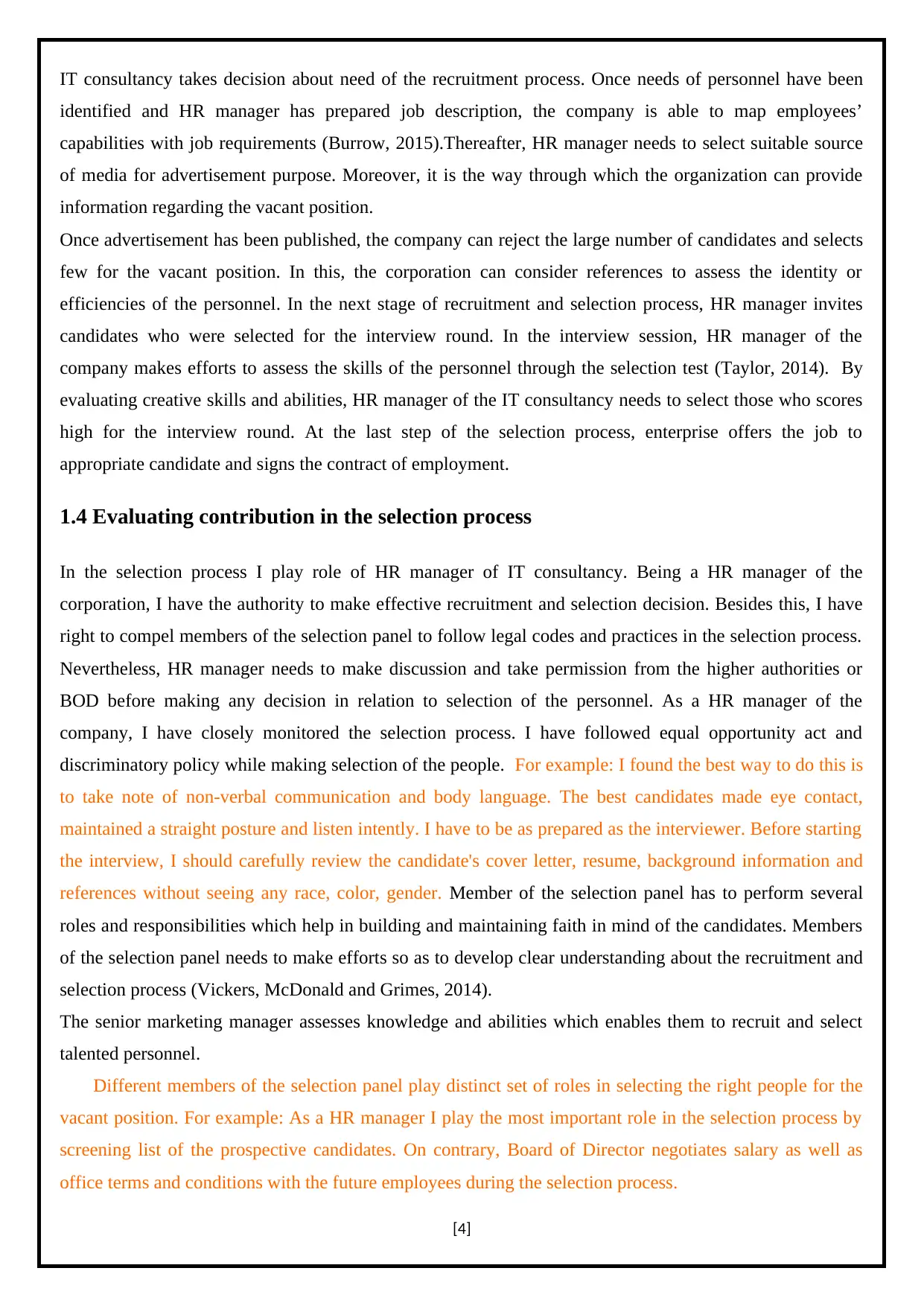
IT consultancy takes decision about need of the recruitment process. Once needs of personnel have been
identified and HR manager has prepared job description, the company is able to map employees’
capabilities with job requirements (Burrow, 2015).Thereafter, HR manager needs to select suitable source
of media for advertisement purpose. Moreover, it is the way through which the organization can provide
information regarding the vacant position.
Once advertisement has been published, the company can reject the large number of candidates and selects
few for the vacant position. In this, the corporation can consider references to assess the identity or
efficiencies of the personnel. In the next stage of recruitment and selection process, HR manager invites
candidates who were selected for the interview round. In the interview session, HR manager of the
company makes efforts to assess the skills of the personnel through the selection test (Taylor, 2014). By
evaluating creative skills and abilities, HR manager of the IT consultancy needs to select those who scores
high for the interview round. At the last step of the selection process, enterprise offers the job to
appropriate candidate and signs the contract of employment.
1.4 Evaluating contribution in the selection process
In the selection process I play role of HR manager of IT consultancy. Being a HR manager of the
corporation, I have the authority to make effective recruitment and selection decision. Besides this, I have
right to compel members of the selection panel to follow legal codes and practices in the selection process.
Nevertheless, HR manager needs to make discussion and take permission from the higher authorities or
BOD before making any decision in relation to selection of the personnel. As a HR manager of the
company, I have closely monitored the selection process. I have followed equal opportunity act and
discriminatory policy while making selection of the people. For example: I found the best way to do this is
to take note of non-verbal communication and body language. The best candidates made eye contact,
maintained a straight posture and listen intently. I have to be as prepared as the interviewer. Before starting
the interview, I should carefully review the candidate's cover letter, resume, background information and
references without seeing any race, color, gender. Member of the selection panel has to perform several
roles and responsibilities which help in building and maintaining faith in mind of the candidates. Members
of the selection panel needs to make efforts so as to develop clear understanding about the recruitment and
selection process (Vickers, McDonald and Grimes, 2014).
The senior marketing manager assesses knowledge and abilities which enables them to recruit and select
talented personnel.
Different members of the selection panel play distinct set of roles in selecting the right people for the
vacant position. For example: As a HR manager I play the most important role in the selection process by
screening list of the prospective candidates. On contrary, Board of Director negotiates salary as well as
office terms and conditions with the future employees during the selection process.
[4]
identified and HR manager has prepared job description, the company is able to map employees’
capabilities with job requirements (Burrow, 2015).Thereafter, HR manager needs to select suitable source
of media for advertisement purpose. Moreover, it is the way through which the organization can provide
information regarding the vacant position.
Once advertisement has been published, the company can reject the large number of candidates and selects
few for the vacant position. In this, the corporation can consider references to assess the identity or
efficiencies of the personnel. In the next stage of recruitment and selection process, HR manager invites
candidates who were selected for the interview round. In the interview session, HR manager of the
company makes efforts to assess the skills of the personnel through the selection test (Taylor, 2014). By
evaluating creative skills and abilities, HR manager of the IT consultancy needs to select those who scores
high for the interview round. At the last step of the selection process, enterprise offers the job to
appropriate candidate and signs the contract of employment.
1.4 Evaluating contribution in the selection process
In the selection process I play role of HR manager of IT consultancy. Being a HR manager of the
corporation, I have the authority to make effective recruitment and selection decision. Besides this, I have
right to compel members of the selection panel to follow legal codes and practices in the selection process.
Nevertheless, HR manager needs to make discussion and take permission from the higher authorities or
BOD before making any decision in relation to selection of the personnel. As a HR manager of the
company, I have closely monitored the selection process. I have followed equal opportunity act and
discriminatory policy while making selection of the people. For example: I found the best way to do this is
to take note of non-verbal communication and body language. The best candidates made eye contact,
maintained a straight posture and listen intently. I have to be as prepared as the interviewer. Before starting
the interview, I should carefully review the candidate's cover letter, resume, background information and
references without seeing any race, color, gender. Member of the selection panel has to perform several
roles and responsibilities which help in building and maintaining faith in mind of the candidates. Members
of the selection panel needs to make efforts so as to develop clear understanding about the recruitment and
selection process (Vickers, McDonald and Grimes, 2014).
The senior marketing manager assesses knowledge and abilities which enables them to recruit and select
talented personnel.
Different members of the selection panel play distinct set of roles in selecting the right people for the
vacant position. For example: As a HR manager I play the most important role in the selection process by
screening list of the prospective candidates. On contrary, Board of Director negotiates salary as well as
office terms and conditions with the future employees during the selection process.
[4]
Paraphrase This Document
Need a fresh take? Get an instant paraphrase of this document with our AI Paraphraser
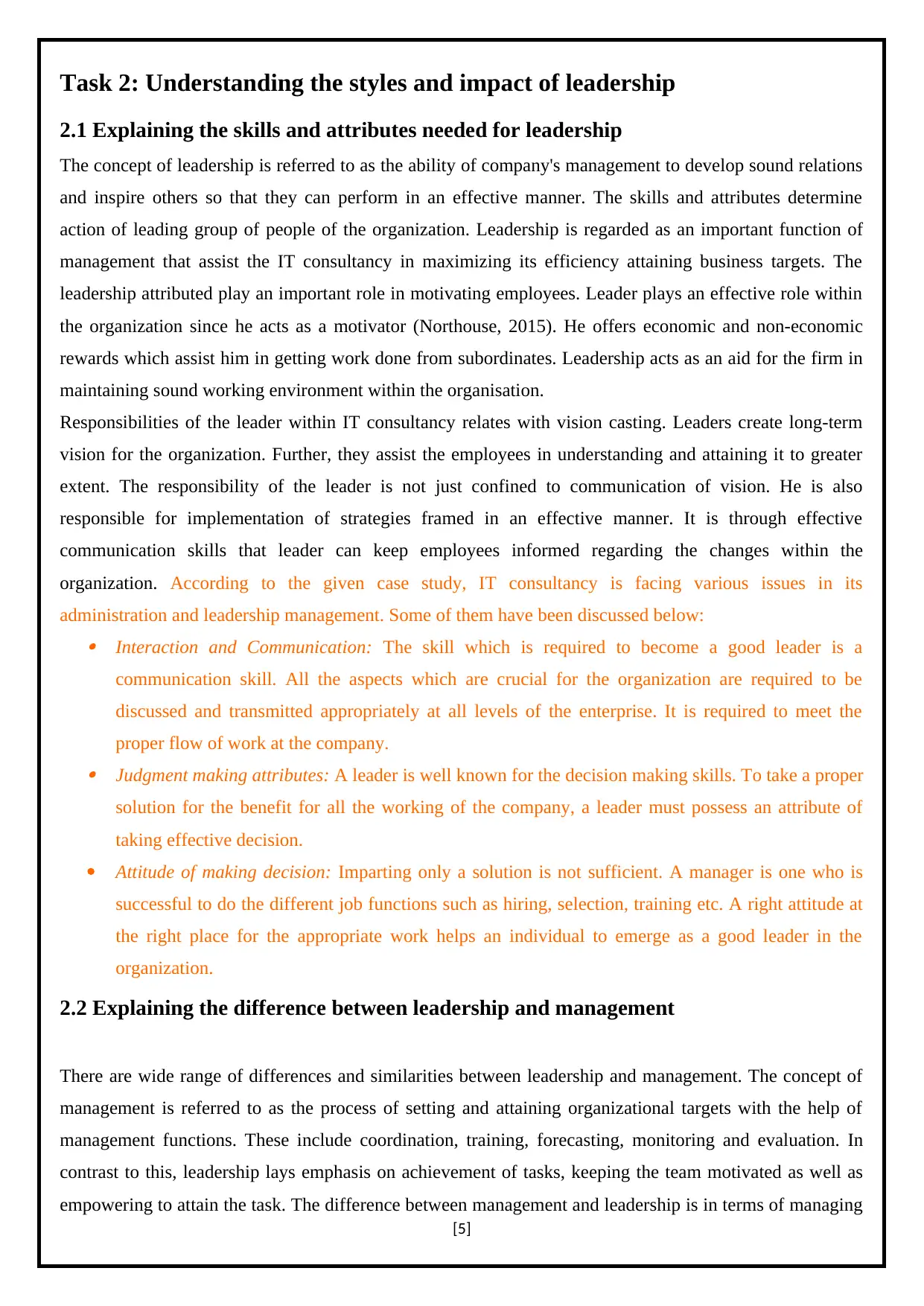
Task 2: Understanding the styles and impact of leadership
2.1 Explaining the skills and attributes needed for leadership
The concept of leadership is referred to as the ability of company's management to develop sound relations
and inspire others so that they can perform in an effective manner. The skills and attributes determine
action of leading group of people of the organization. Leadership is regarded as an important function of
management that assist the IT consultancy in maximizing its efficiency attaining business targets. The
leadership attributed play an important role in motivating employees. Leader plays an effective role within
the organization since he acts as a motivator (Northouse, 2015). He offers economic and non-economic
rewards which assist him in getting work done from subordinates. Leadership acts as an aid for the firm in
maintaining sound working environment within the organisation.
Responsibilities of the leader within IT consultancy relates with vision casting. Leaders create long-term
vision for the organization. Further, they assist the employees in understanding and attaining it to greater
extent. The responsibility of the leader is not just confined to communication of vision. He is also
responsible for implementation of strategies framed in an effective manner. It is through effective
communication skills that leader can keep employees informed regarding the changes within the
organization. According to the given case study, IT consultancy is facing various issues in its
administration and leadership management. Some of them have been discussed below: Interaction and Communication: The skill which is required to become a good leader is a
communication skill. All the aspects which are crucial for the organization are required to be
discussed and transmitted appropriately at all levels of the enterprise. It is required to meet the
proper flow of work at the company. Judgment making attributes: A leader is well known for the decision making skills. To take a proper
solution for the benefit for all the working of the company, a leader must possess an attribute of
taking effective decision.
Attitude of making decision: Imparting only a solution is not sufficient. A manager is one who is
successful to do the different job functions such as hiring, selection, training etc. A right attitude at
the right place for the appropriate work helps an individual to emerge as a good leader in the
organization.
2.2 Explaining the difference between leadership and management
There are wide range of differences and similarities between leadership and management. The concept of
management is referred to as the process of setting and attaining organizational targets with the help of
management functions. These include coordination, training, forecasting, monitoring and evaluation. In
contrast to this, leadership lays emphasis on achievement of tasks, keeping the team motivated as well as
empowering to attain the task. The difference between management and leadership is in terms of managing
[5]
2.1 Explaining the skills and attributes needed for leadership
The concept of leadership is referred to as the ability of company's management to develop sound relations
and inspire others so that they can perform in an effective manner. The skills and attributes determine
action of leading group of people of the organization. Leadership is regarded as an important function of
management that assist the IT consultancy in maximizing its efficiency attaining business targets. The
leadership attributed play an important role in motivating employees. Leader plays an effective role within
the organization since he acts as a motivator (Northouse, 2015). He offers economic and non-economic
rewards which assist him in getting work done from subordinates. Leadership acts as an aid for the firm in
maintaining sound working environment within the organisation.
Responsibilities of the leader within IT consultancy relates with vision casting. Leaders create long-term
vision for the organization. Further, they assist the employees in understanding and attaining it to greater
extent. The responsibility of the leader is not just confined to communication of vision. He is also
responsible for implementation of strategies framed in an effective manner. It is through effective
communication skills that leader can keep employees informed regarding the changes within the
organization. According to the given case study, IT consultancy is facing various issues in its
administration and leadership management. Some of them have been discussed below: Interaction and Communication: The skill which is required to become a good leader is a
communication skill. All the aspects which are crucial for the organization are required to be
discussed and transmitted appropriately at all levels of the enterprise. It is required to meet the
proper flow of work at the company. Judgment making attributes: A leader is well known for the decision making skills. To take a proper
solution for the benefit for all the working of the company, a leader must possess an attribute of
taking effective decision.
Attitude of making decision: Imparting only a solution is not sufficient. A manager is one who is
successful to do the different job functions such as hiring, selection, training etc. A right attitude at
the right place for the appropriate work helps an individual to emerge as a good leader in the
organization.
2.2 Explaining the difference between leadership and management
There are wide range of differences and similarities between leadership and management. The concept of
management is referred to as the process of setting and attaining organizational targets with the help of
management functions. These include coordination, training, forecasting, monitoring and evaluation. In
contrast to this, leadership lays emphasis on achievement of tasks, keeping the team motivated as well as
empowering to attain the task. The difference between management and leadership is in terms of managing
[5]
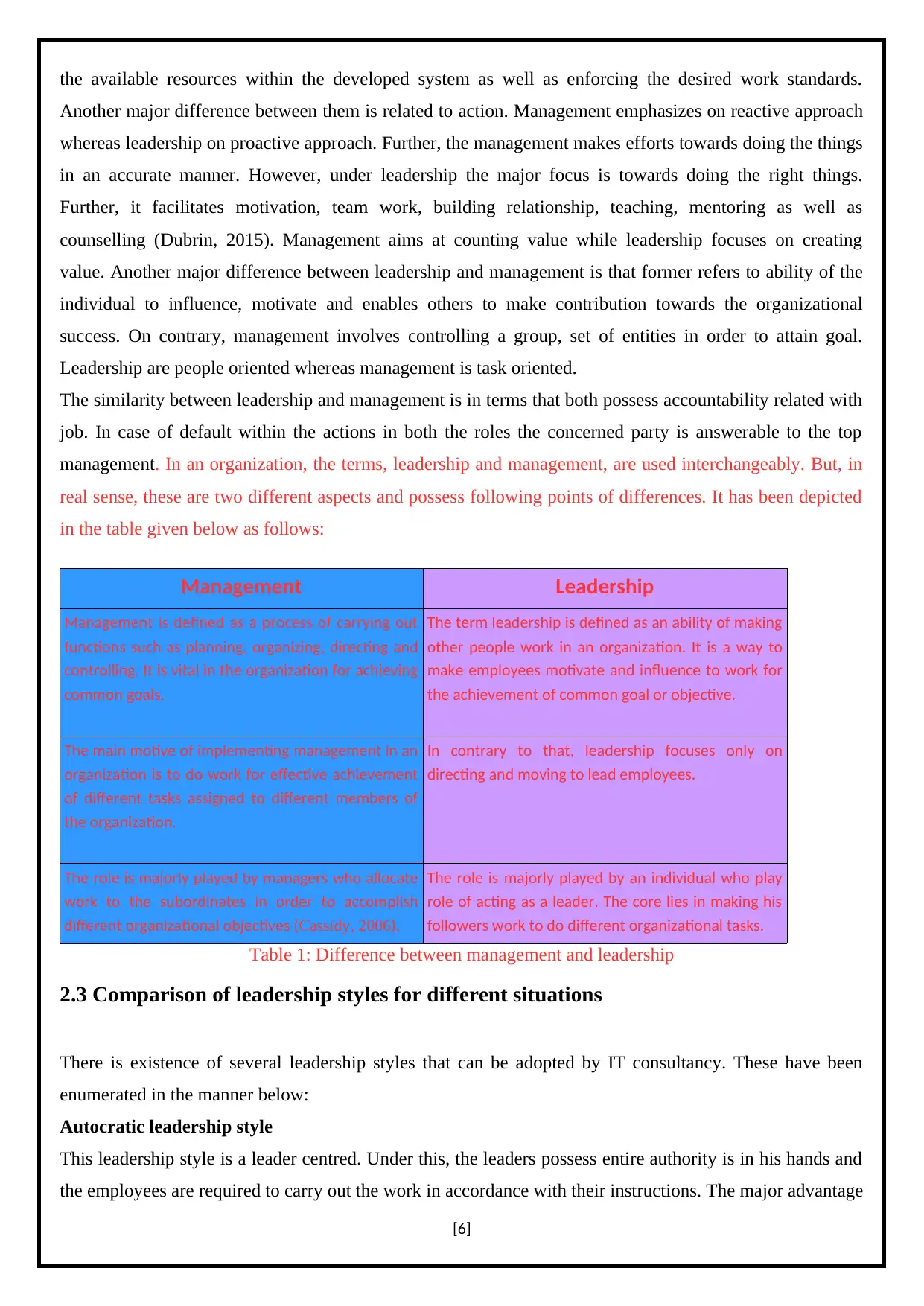
the available resources within the developed system as well as enforcing the desired work standards.
Another major difference between them is related to action. Management emphasizes on reactive approach
whereas leadership on proactive approach. Further, the management makes efforts towards doing the things
in an accurate manner. However, under leadership the major focus is towards doing the right things.
Further, it facilitates motivation, team work, building relationship, teaching, mentoring as well as
counselling (Dubrin, 2015). Management aims at counting value while leadership focuses on creating
value. Another major difference between leadership and management is that former refers to ability of the
individual to influence, motivate and enables others to make contribution towards the organizational
success. On contrary, management involves controlling a group, set of entities in order to attain goal.
Leadership are people oriented whereas management is task oriented.
The similarity between leadership and management is in terms that both possess accountability related with
job. In case of default within the actions in both the roles the concerned party is answerable to the top
management. In an organization, the terms, leadership and management, are used interchangeably. But, in
real sense, these are two different aspects and possess following points of differences. It has been depicted
in the table given below as follows:
Management Leadership
Management is defined as a process of carrying out
functions such as planning, organizing, directing and
controlling. It is vital in the organization for achieving
common goals.
The term leadership is defined as an ability of making
other people work in an organization. It is a way to
make employees motivate and influence to work for
the achievement of common goal or objective.
The main motive of implementing management in an
organization is to do work for effective achievement
of different tasks assigned to different members of
the organization.
In contrary to that, leadership focuses only on
directing and moving to lead employees.
The role is majorly played by managers who allocate
work to the subordinates in order to accomplish
different organizational objectives (Cassidy, 2006).
The role is majorly played by an individual who play
role of acting as a leader. The core lies in making his
followers work to do different organizational tasks.
Table 1: Difference between management and leadership
2.3 Comparison of leadership styles for different situations
There is existence of several leadership styles that can be adopted by IT consultancy. These have been
enumerated in the manner below:
Autocratic leadership style
This leadership style is a leader centred. Under this, the leaders possess entire authority is in his hands and
the employees are required to carry out the work in accordance with their instructions. The major advantage
[6]
Another major difference between them is related to action. Management emphasizes on reactive approach
whereas leadership on proactive approach. Further, the management makes efforts towards doing the things
in an accurate manner. However, under leadership the major focus is towards doing the right things.
Further, it facilitates motivation, team work, building relationship, teaching, mentoring as well as
counselling (Dubrin, 2015). Management aims at counting value while leadership focuses on creating
value. Another major difference between leadership and management is that former refers to ability of the
individual to influence, motivate and enables others to make contribution towards the organizational
success. On contrary, management involves controlling a group, set of entities in order to attain goal.
Leadership are people oriented whereas management is task oriented.
The similarity between leadership and management is in terms that both possess accountability related with
job. In case of default within the actions in both the roles the concerned party is answerable to the top
management. In an organization, the terms, leadership and management, are used interchangeably. But, in
real sense, these are two different aspects and possess following points of differences. It has been depicted
in the table given below as follows:
Management Leadership
Management is defined as a process of carrying out
functions such as planning, organizing, directing and
controlling. It is vital in the organization for achieving
common goals.
The term leadership is defined as an ability of making
other people work in an organization. It is a way to
make employees motivate and influence to work for
the achievement of common goal or objective.
The main motive of implementing management in an
organization is to do work for effective achievement
of different tasks assigned to different members of
the organization.
In contrary to that, leadership focuses only on
directing and moving to lead employees.
The role is majorly played by managers who allocate
work to the subordinates in order to accomplish
different organizational objectives (Cassidy, 2006).
The role is majorly played by an individual who play
role of acting as a leader. The core lies in making his
followers work to do different organizational tasks.
Table 1: Difference between management and leadership
2.3 Comparison of leadership styles for different situations
There is existence of several leadership styles that can be adopted by IT consultancy. These have been
enumerated in the manner below:
Autocratic leadership style
This leadership style is a leader centred. Under this, the leaders possess entire authority is in his hands and
the employees are required to carry out the work in accordance with their instructions. The major advantage
[6]
⊘ This is a preview!⊘
Do you want full access?
Subscribe today to unlock all pages.

Trusted by 1+ million students worldwide
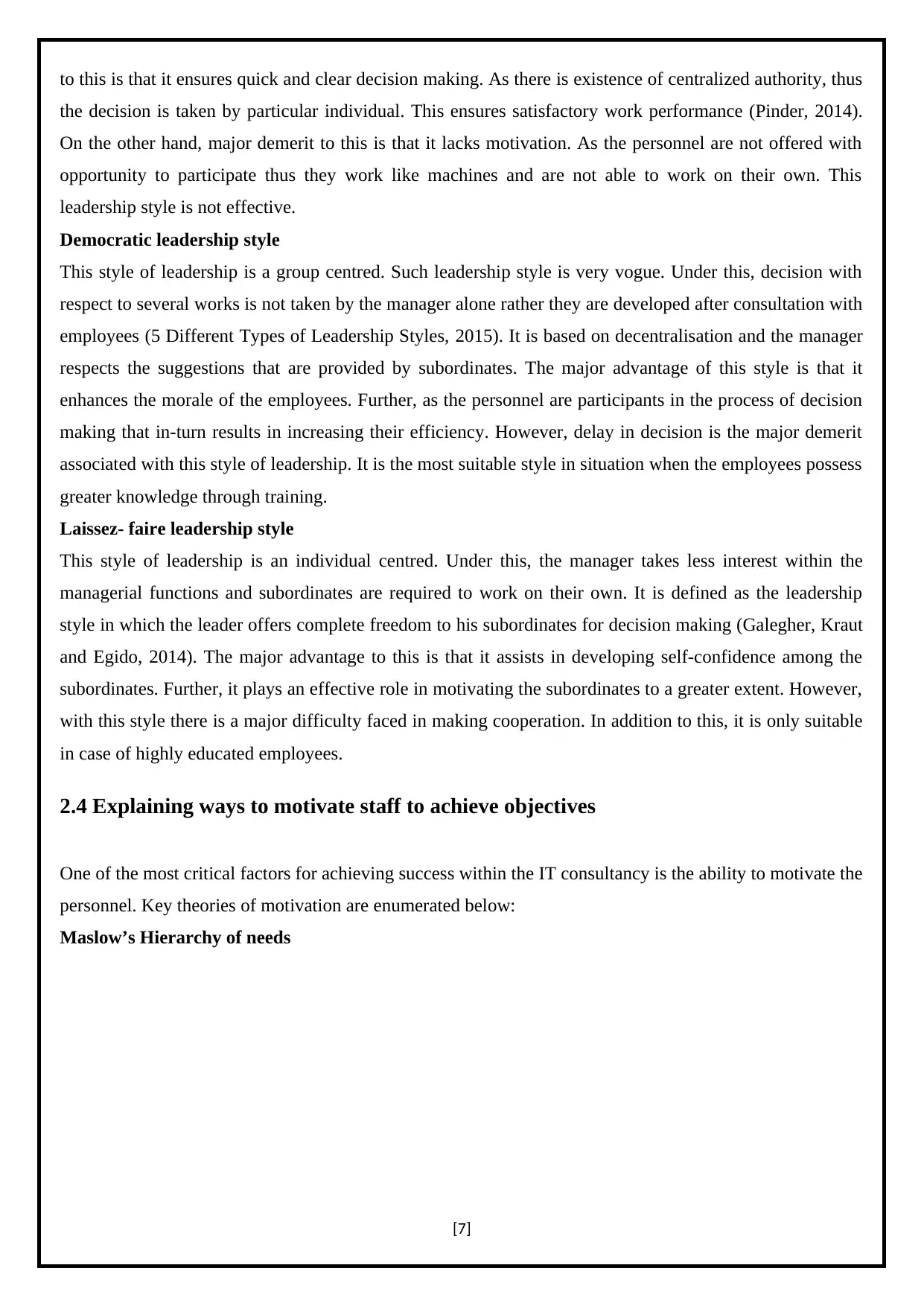
to this is that it ensures quick and clear decision making. As there is existence of centralized authority, thus
the decision is taken by particular individual. This ensures satisfactory work performance (Pinder, 2014).
On the other hand, major demerit to this is that it lacks motivation. As the personnel are not offered with
opportunity to participate thus they work like machines and are not able to work on their own. This
leadership style is not effective.
Democratic leadership style
This style of leadership is a group centred. Such leadership style is very vogue. Under this, decision with
respect to several works is not taken by the manager alone rather they are developed after consultation with
employees (5 Different Types of Leadership Styles, 2015). It is based on decentralisation and the manager
respects the suggestions that are provided by subordinates. The major advantage of this style is that it
enhances the morale of the employees. Further, as the personnel are participants in the process of decision
making that in-turn results in increasing their efficiency. However, delay in decision is the major demerit
associated with this style of leadership. It is the most suitable style in situation when the employees possess
greater knowledge through training.
Laissez- faire leadership style
This style of leadership is an individual centred. Under this, the manager takes less interest within the
managerial functions and subordinates are required to work on their own. It is defined as the leadership
style in which the leader offers complete freedom to his subordinates for decision making (Galegher, Kraut
and Egido, 2014). The major advantage to this is that it assists in developing self-confidence among the
subordinates. Further, it plays an effective role in motivating the subordinates to a greater extent. However,
with this style there is a major difficulty faced in making cooperation. In addition to this, it is only suitable
in case of highly educated employees.
2.4 Explaining ways to motivate staff to achieve objectives
One of the most critical factors for achieving success within the IT consultancy is the ability to motivate the
personnel. Key theories of motivation are enumerated below:
Maslow’s Hierarchy of needs
[7]
the decision is taken by particular individual. This ensures satisfactory work performance (Pinder, 2014).
On the other hand, major demerit to this is that it lacks motivation. As the personnel are not offered with
opportunity to participate thus they work like machines and are not able to work on their own. This
leadership style is not effective.
Democratic leadership style
This style of leadership is a group centred. Such leadership style is very vogue. Under this, decision with
respect to several works is not taken by the manager alone rather they are developed after consultation with
employees (5 Different Types of Leadership Styles, 2015). It is based on decentralisation and the manager
respects the suggestions that are provided by subordinates. The major advantage of this style is that it
enhances the morale of the employees. Further, as the personnel are participants in the process of decision
making that in-turn results in increasing their efficiency. However, delay in decision is the major demerit
associated with this style of leadership. It is the most suitable style in situation when the employees possess
greater knowledge through training.
Laissez- faire leadership style
This style of leadership is an individual centred. Under this, the manager takes less interest within the
managerial functions and subordinates are required to work on their own. It is defined as the leadership
style in which the leader offers complete freedom to his subordinates for decision making (Galegher, Kraut
and Egido, 2014). The major advantage to this is that it assists in developing self-confidence among the
subordinates. Further, it plays an effective role in motivating the subordinates to a greater extent. However,
with this style there is a major difficulty faced in making cooperation. In addition to this, it is only suitable
in case of highly educated employees.
2.4 Explaining ways to motivate staff to achieve objectives
One of the most critical factors for achieving success within the IT consultancy is the ability to motivate the
personnel. Key theories of motivation are enumerated below:
Maslow’s Hierarchy of needs
[7]
Paraphrase This Document
Need a fresh take? Get an instant paraphrase of this document with our AI Paraphraser
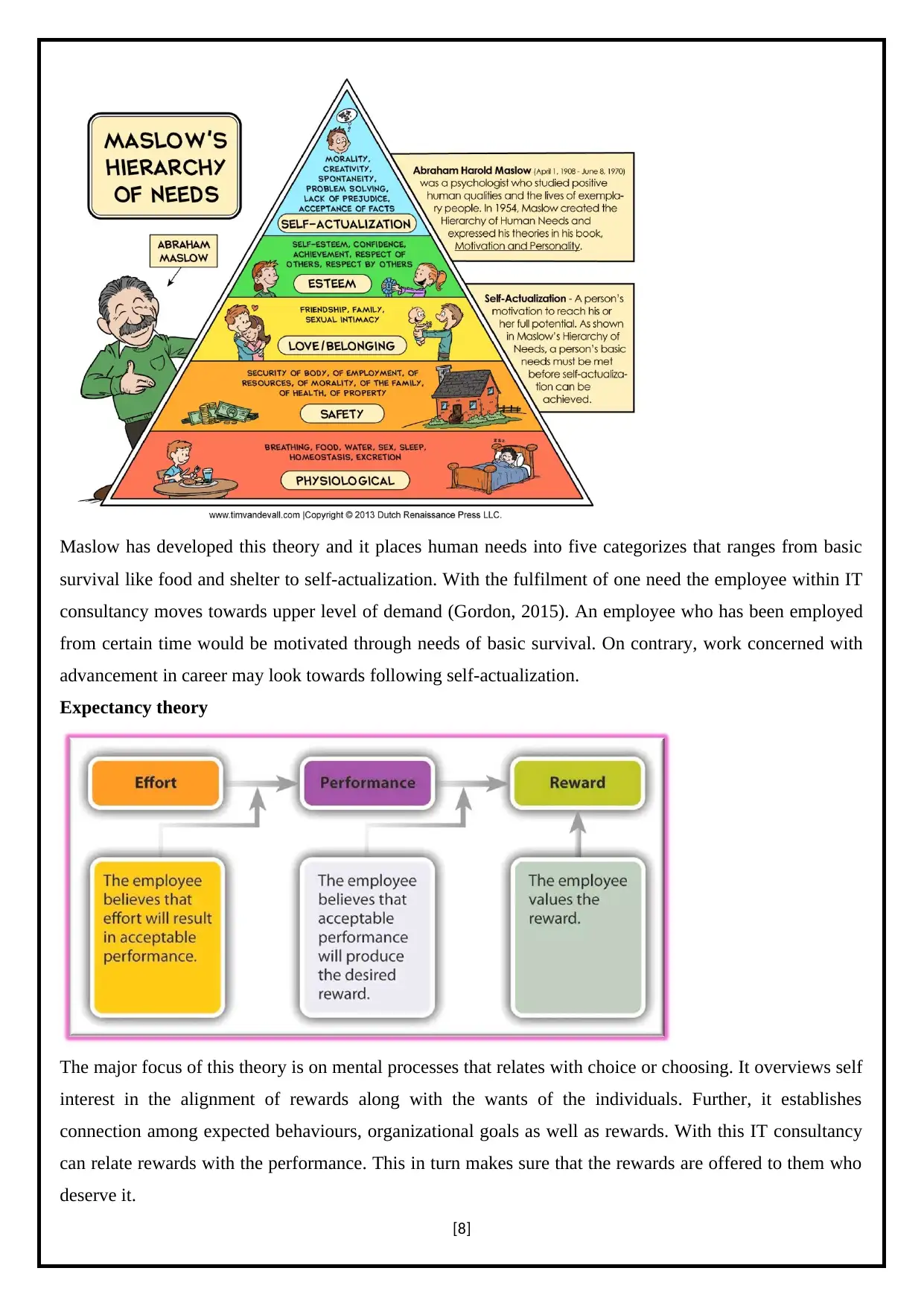
Maslow has developed this theory and it places human needs into five categorizes that ranges from basic
survival like food and shelter to self-actualization. With the fulfilment of one need the employee within IT
consultancy moves towards upper level of demand (Gordon, 2015). An employee who has been employed
from certain time would be motivated through needs of basic survival. On contrary, work concerned with
advancement in career may look towards following self-actualization.
Expectancy theory
The major focus of this theory is on mental processes that relates with choice or choosing. It overviews self
interest in the alignment of rewards along with the wants of the individuals. Further, it establishes
connection among expected behaviours, organizational goals as well as rewards. With this IT consultancy
can relate rewards with the performance. This in turn makes sure that the rewards are offered to them who
deserve it.
[8]
survival like food and shelter to self-actualization. With the fulfilment of one need the employee within IT
consultancy moves towards upper level of demand (Gordon, 2015). An employee who has been employed
from certain time would be motivated through needs of basic survival. On contrary, work concerned with
advancement in career may look towards following self-actualization.
Expectancy theory
The major focus of this theory is on mental processes that relates with choice or choosing. It overviews self
interest in the alignment of rewards along with the wants of the individuals. Further, it establishes
connection among expected behaviours, organizational goals as well as rewards. With this IT consultancy
can relate rewards with the performance. This in turn makes sure that the rewards are offered to them who
deserve it.
[8]
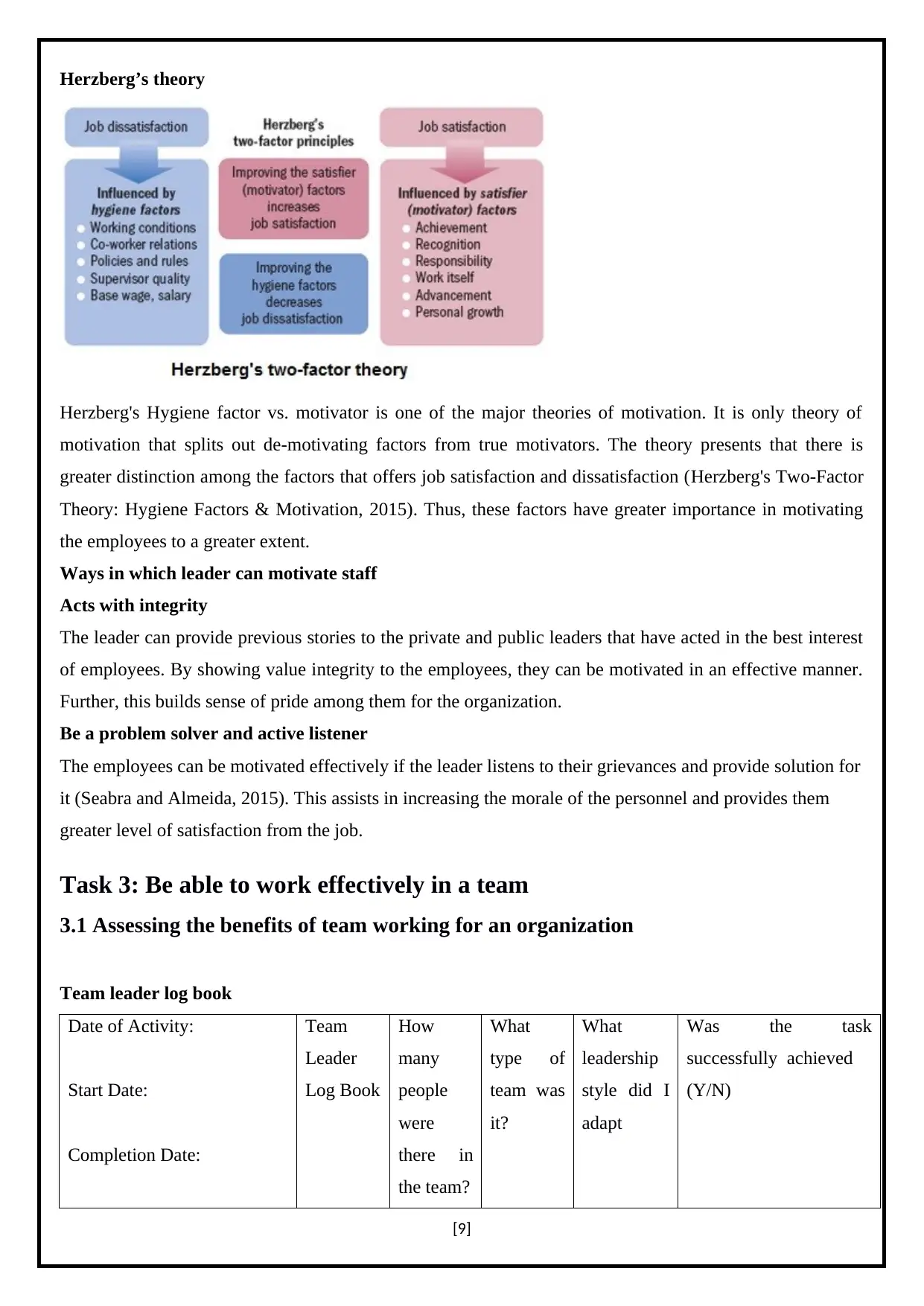
Herzberg’s theory
Herzberg's Hygiene factor vs. motivator is one of the major theories of motivation. It is only theory of
motivation that splits out de-motivating factors from true motivators. The theory presents that there is
greater distinction among the factors that offers job satisfaction and dissatisfaction (Herzberg's Two-Factor
Theory: Hygiene Factors & Motivation, 2015). Thus, these factors have greater importance in motivating
the employees to a greater extent.
Ways in which leader can motivate staff
Acts with integrity
The leader can provide previous stories to the private and public leaders that have acted in the best interest
of employees. By showing value integrity to the employees, they can be motivated in an effective manner.
Further, this builds sense of pride among them for the organization.
Be a problem solver and active listener
The employees can be motivated effectively if the leader listens to their grievances and provide solution for
it (Seabra and Almeida, 2015). This assists in increasing the morale of the personnel and provides them
greater level of satisfaction from the job.
Task 3: Be able to work effectively in a team
3.1 Assessing the benefits of team working for an organization
Team leader log book
Date of Activity:
Start Date:
Completion Date:
Team
Leader
Log Book
How
many
people
were
there in
the team?
What
type of
team was
it?
What
leadership
style did I
adapt
Was the task
successfully achieved
(Y/N)
[9]
Herzberg's Hygiene factor vs. motivator is one of the major theories of motivation. It is only theory of
motivation that splits out de-motivating factors from true motivators. The theory presents that there is
greater distinction among the factors that offers job satisfaction and dissatisfaction (Herzberg's Two-Factor
Theory: Hygiene Factors & Motivation, 2015). Thus, these factors have greater importance in motivating
the employees to a greater extent.
Ways in which leader can motivate staff
Acts with integrity
The leader can provide previous stories to the private and public leaders that have acted in the best interest
of employees. By showing value integrity to the employees, they can be motivated in an effective manner.
Further, this builds sense of pride among them for the organization.
Be a problem solver and active listener
The employees can be motivated effectively if the leader listens to their grievances and provide solution for
it (Seabra and Almeida, 2015). This assists in increasing the morale of the personnel and provides them
greater level of satisfaction from the job.
Task 3: Be able to work effectively in a team
3.1 Assessing the benefits of team working for an organization
Team leader log book
Date of Activity:
Start Date:
Completion Date:
Team
Leader
Log Book
How
many
people
were
there in
the team?
What
type of
team was
it?
What
leadership
style did I
adapt
Was the task
successfully achieved
(Y/N)
[9]
⊘ This is a preview!⊘
Do you want full access?
Subscribe today to unlock all pages.

Trusted by 1+ million students worldwide
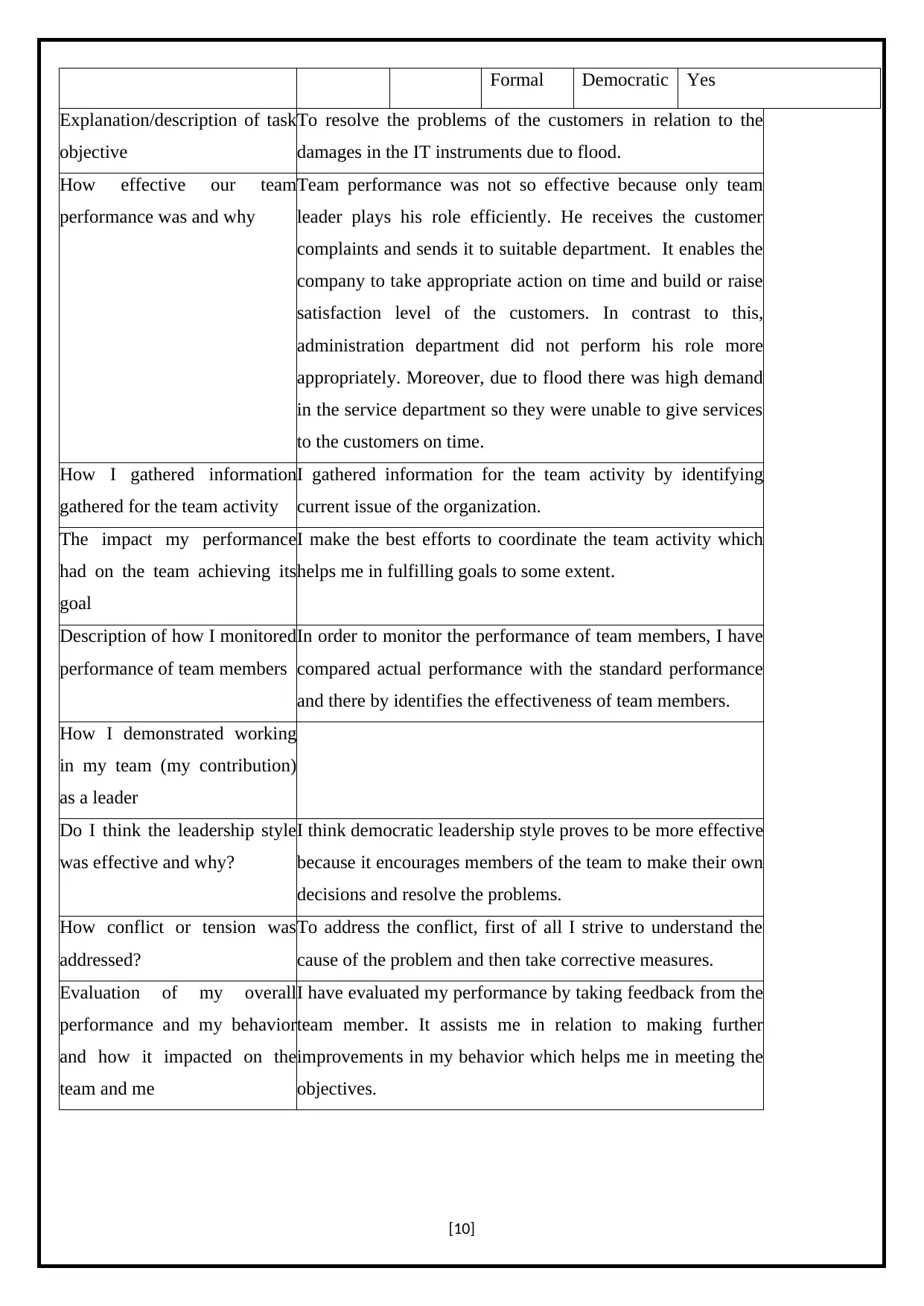
Formal Democratic Yes
Explanation/description of task
objective
To resolve the problems of the customers in relation to the
damages in the IT instruments due to flood.
How effective our team
performance was and why
Team performance was not so effective because only team
leader plays his role efficiently. He receives the customer
complaints and sends it to suitable department. It enables the
company to take appropriate action on time and build or raise
satisfaction level of the customers. In contrast to this,
administration department did not perform his role more
appropriately. Moreover, due to flood there was high demand
in the service department so they were unable to give services
to the customers on time.
How I gathered information
gathered for the team activity
I gathered information for the team activity by identifying
current issue of the organization.
The impact my performance
had on the team achieving its
goal
I make the best efforts to coordinate the team activity which
helps me in fulfilling goals to some extent.
Description of how I monitored
performance of team members
In order to monitor the performance of team members, I have
compared actual performance with the standard performance
and there by identifies the effectiveness of team members.
How I demonstrated working
in my team (my contribution)
as a leader
Do I think the leadership style
was effective and why?
I think democratic leadership style proves to be more effective
because it encourages members of the team to make their own
decisions and resolve the problems.
How conflict or tension was
addressed?
To address the conflict, first of all I strive to understand the
cause of the problem and then take corrective measures.
Evaluation of my overall
performance and my behavior
and how it impacted on the
team and me
I have evaluated my performance by taking feedback from the
team member. It assists me in relation to making further
improvements in my behavior which helps me in meeting the
objectives.
[10]
Explanation/description of task
objective
To resolve the problems of the customers in relation to the
damages in the IT instruments due to flood.
How effective our team
performance was and why
Team performance was not so effective because only team
leader plays his role efficiently. He receives the customer
complaints and sends it to suitable department. It enables the
company to take appropriate action on time and build or raise
satisfaction level of the customers. In contrast to this,
administration department did not perform his role more
appropriately. Moreover, due to flood there was high demand
in the service department so they were unable to give services
to the customers on time.
How I gathered information
gathered for the team activity
I gathered information for the team activity by identifying
current issue of the organization.
The impact my performance
had on the team achieving its
goal
I make the best efforts to coordinate the team activity which
helps me in fulfilling goals to some extent.
Description of how I monitored
performance of team members
In order to monitor the performance of team members, I have
compared actual performance with the standard performance
and there by identifies the effectiveness of team members.
How I demonstrated working
in my team (my contribution)
as a leader
Do I think the leadership style
was effective and why?
I think democratic leadership style proves to be more effective
because it encourages members of the team to make their own
decisions and resolve the problems.
How conflict or tension was
addressed?
To address the conflict, first of all I strive to understand the
cause of the problem and then take corrective measures.
Evaluation of my overall
performance and my behavior
and how it impacted on the
team and me
I have evaluated my performance by taking feedback from the
team member. It assists me in relation to making further
improvements in my behavior which helps me in meeting the
objectives.
[10]
Paraphrase This Document
Need a fresh take? Get an instant paraphrase of this document with our AI Paraphraser
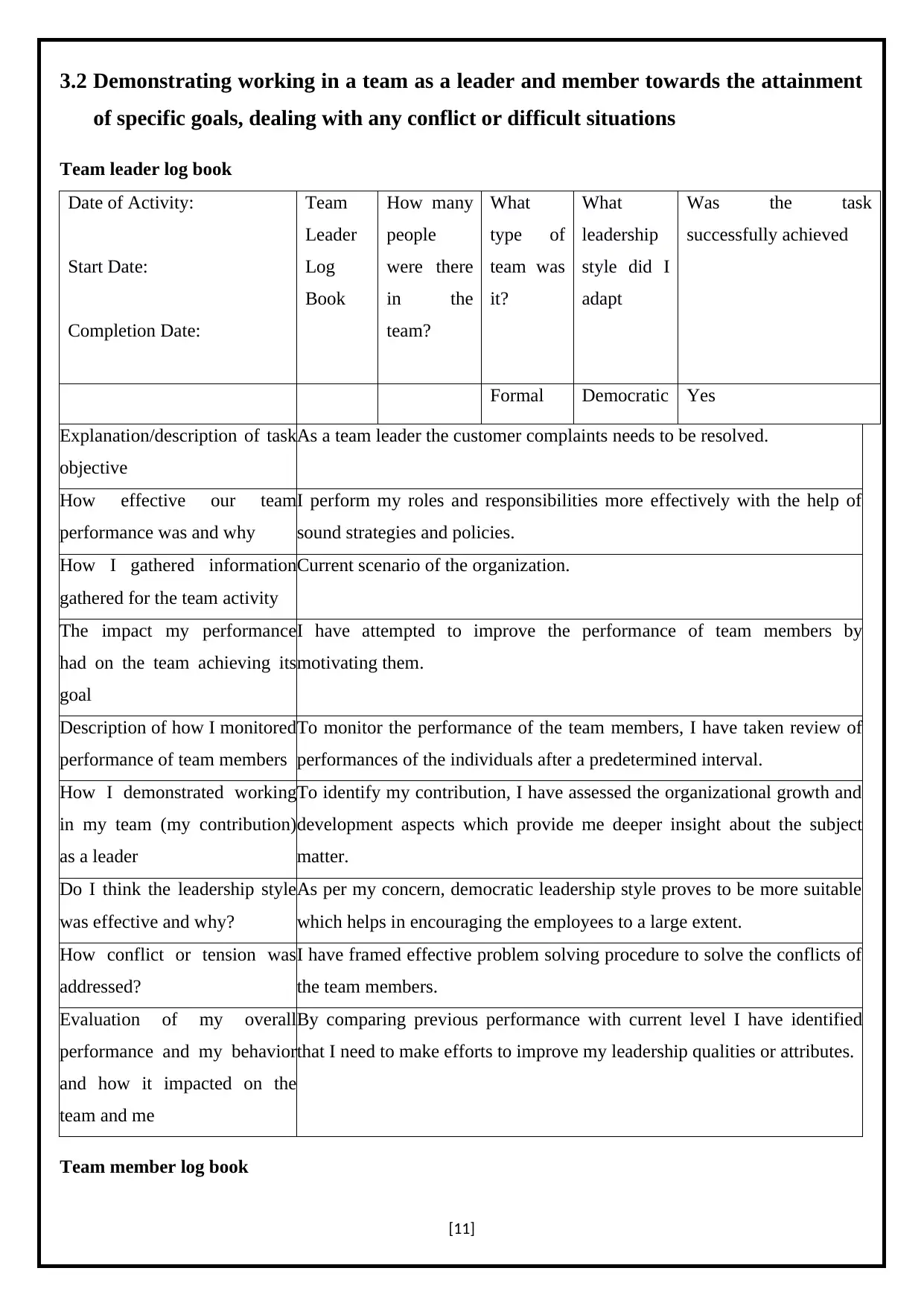
3.2 Demonstrating working in a team as a leader and member towards the attainment
of specific goals, dealing with any conflict or difficult situations
Team leader log book
Date of Activity:
Start Date:
Completion Date:
Team
Leader
Log
Book
How many
people
were there
in the
team?
What
type of
team was
it?
What
leadership
style did I
adapt
Was the task
successfully achieved
Formal Democratic Yes
Explanation/description of task
objective
As a team leader the customer complaints needs to be resolved.
How effective our team
performance was and why
I perform my roles and responsibilities more effectively with the help of
sound strategies and policies.
How I gathered information
gathered for the team activity
Current scenario of the organization.
The impact my performance
had on the team achieving its
goal
I have attempted to improve the performance of team members by
motivating them.
Description of how I monitored
performance of team members
To monitor the performance of the team members, I have taken review of
performances of the individuals after a predetermined interval.
How I demonstrated working
in my team (my contribution)
as a leader
To identify my contribution, I have assessed the organizational growth and
development aspects which provide me deeper insight about the subject
matter.
Do I think the leadership style
was effective and why?
As per my concern, democratic leadership style proves to be more suitable
which helps in encouraging the employees to a large extent.
How conflict or tension was
addressed?
I have framed effective problem solving procedure to solve the conflicts of
the team members.
Evaluation of my overall
performance and my behavior
and how it impacted on the
team and me
By comparing previous performance with current level I have identified
that I need to make efforts to improve my leadership qualities or attributes.
Team member log book
[11]
of specific goals, dealing with any conflict or difficult situations
Team leader log book
Date of Activity:
Start Date:
Completion Date:
Team
Leader
Log
Book
How many
people
were there
in the
team?
What
type of
team was
it?
What
leadership
style did I
adapt
Was the task
successfully achieved
Formal Democratic Yes
Explanation/description of task
objective
As a team leader the customer complaints needs to be resolved.
How effective our team
performance was and why
I perform my roles and responsibilities more effectively with the help of
sound strategies and policies.
How I gathered information
gathered for the team activity
Current scenario of the organization.
The impact my performance
had on the team achieving its
goal
I have attempted to improve the performance of team members by
motivating them.
Description of how I monitored
performance of team members
To monitor the performance of the team members, I have taken review of
performances of the individuals after a predetermined interval.
How I demonstrated working
in my team (my contribution)
as a leader
To identify my contribution, I have assessed the organizational growth and
development aspects which provide me deeper insight about the subject
matter.
Do I think the leadership style
was effective and why?
As per my concern, democratic leadership style proves to be more suitable
which helps in encouraging the employees to a large extent.
How conflict or tension was
addressed?
I have framed effective problem solving procedure to solve the conflicts of
the team members.
Evaluation of my overall
performance and my behavior
and how it impacted on the
team and me
By comparing previous performance with current level I have identified
that I need to make efforts to improve my leadership qualities or attributes.
Team member log book
[11]
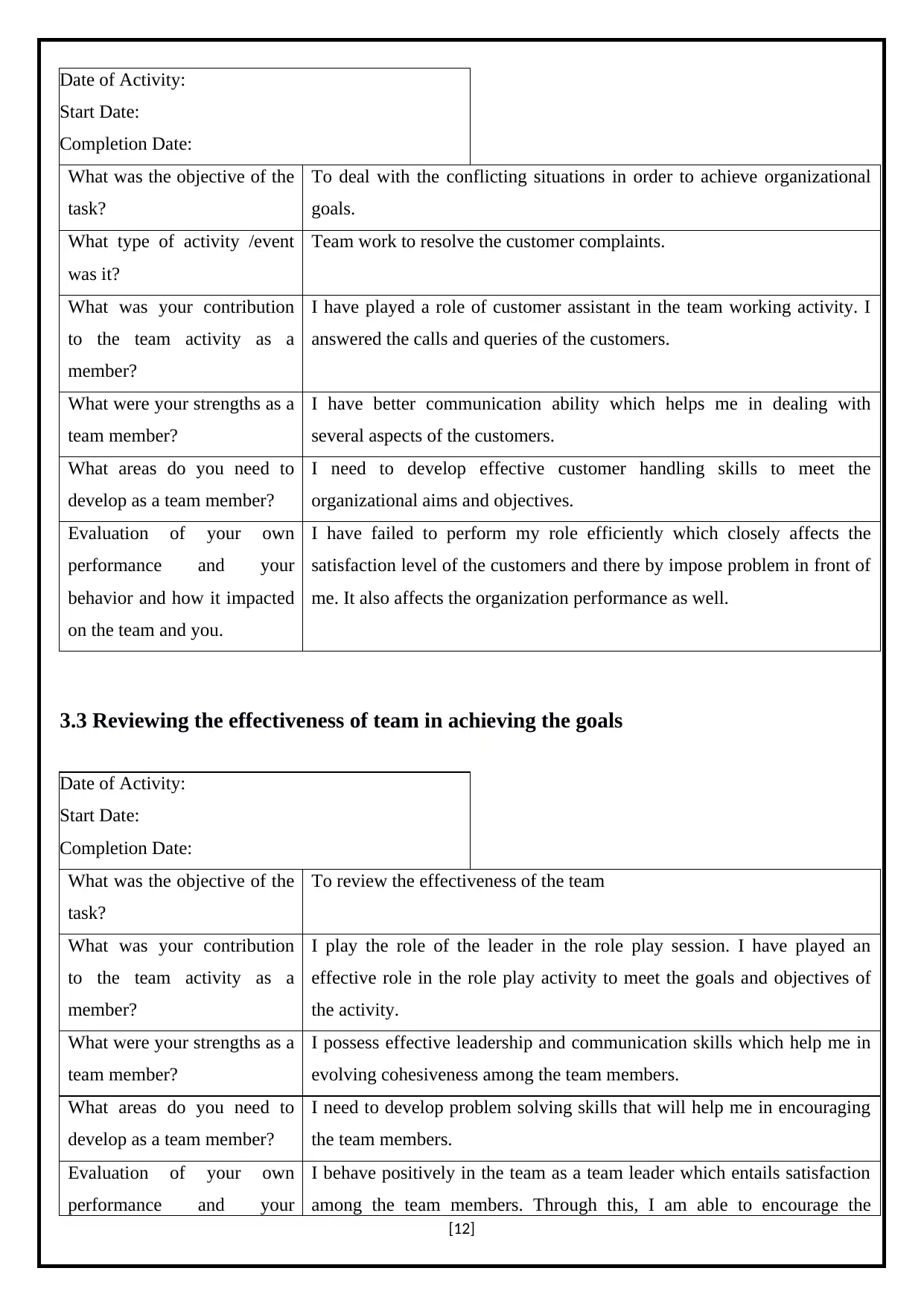
Date of Activity:
Start Date:
Completion Date:
What was the objective of the
task?
To deal with the conflicting situations in order to achieve organizational
goals.
What type of activity /event
was it?
Team work to resolve the customer complaints.
What was your contribution
to the team activity as a
member?
I have played a role of customer assistant in the team working activity. I
answered the calls and queries of the customers.
What were your strengths as a
team member?
I have better communication ability which helps me in dealing with
several aspects of the customers.
What areas do you need to
develop as a team member?
I need to develop effective customer handling skills to meet the
organizational aims and objectives.
Evaluation of your own
performance and your
behavior and how it impacted
on the team and you.
I have failed to perform my role efficiently which closely affects the
satisfaction level of the customers and there by impose problem in front of
me. It also affects the organization performance as well.
3.3 Reviewing the effectiveness of team in achieving the goals
Date of Activity:
Start Date:
Completion Date:
What was the objective of the
task?
To review the effectiveness of the team
What was your contribution
to the team activity as a
member?
I play the role of the leader in the role play session. I have played an
effective role in the role play activity to meet the goals and objectives of
the activity.
What were your strengths as a
team member?
I possess effective leadership and communication skills which help me in
evolving cohesiveness among the team members.
What areas do you need to
develop as a team member?
I need to develop problem solving skills that will help me in encouraging
the team members.
Evaluation of your own
performance and your
I behave positively in the team as a team leader which entails satisfaction
among the team members. Through this, I am able to encourage the
[12]
Start Date:
Completion Date:
What was the objective of the
task?
To deal with the conflicting situations in order to achieve organizational
goals.
What type of activity /event
was it?
Team work to resolve the customer complaints.
What was your contribution
to the team activity as a
member?
I have played a role of customer assistant in the team working activity. I
answered the calls and queries of the customers.
What were your strengths as a
team member?
I have better communication ability which helps me in dealing with
several aspects of the customers.
What areas do you need to
develop as a team member?
I need to develop effective customer handling skills to meet the
organizational aims and objectives.
Evaluation of your own
performance and your
behavior and how it impacted
on the team and you.
I have failed to perform my role efficiently which closely affects the
satisfaction level of the customers and there by impose problem in front of
me. It also affects the organization performance as well.
3.3 Reviewing the effectiveness of team in achieving the goals
Date of Activity:
Start Date:
Completion Date:
What was the objective of the
task?
To review the effectiveness of the team
What was your contribution
to the team activity as a
member?
I play the role of the leader in the role play session. I have played an
effective role in the role play activity to meet the goals and objectives of
the activity.
What were your strengths as a
team member?
I possess effective leadership and communication skills which help me in
evolving cohesiveness among the team members.
What areas do you need to
develop as a team member?
I need to develop problem solving skills that will help me in encouraging
the team members.
Evaluation of your own
performance and your
I behave positively in the team as a team leader which entails satisfaction
among the team members. Through this, I am able to encourage the
[12]
⊘ This is a preview!⊘
Do you want full access?
Subscribe today to unlock all pages.

Trusted by 1+ million students worldwide
1 out of 15
Related Documents
Your All-in-One AI-Powered Toolkit for Academic Success.
+13062052269
info@desklib.com
Available 24*7 on WhatsApp / Email
![[object Object]](/_next/static/media/star-bottom.7253800d.svg)
Unlock your academic potential
Copyright © 2020–2025 A2Z Services. All Rights Reserved. Developed and managed by ZUCOL.




